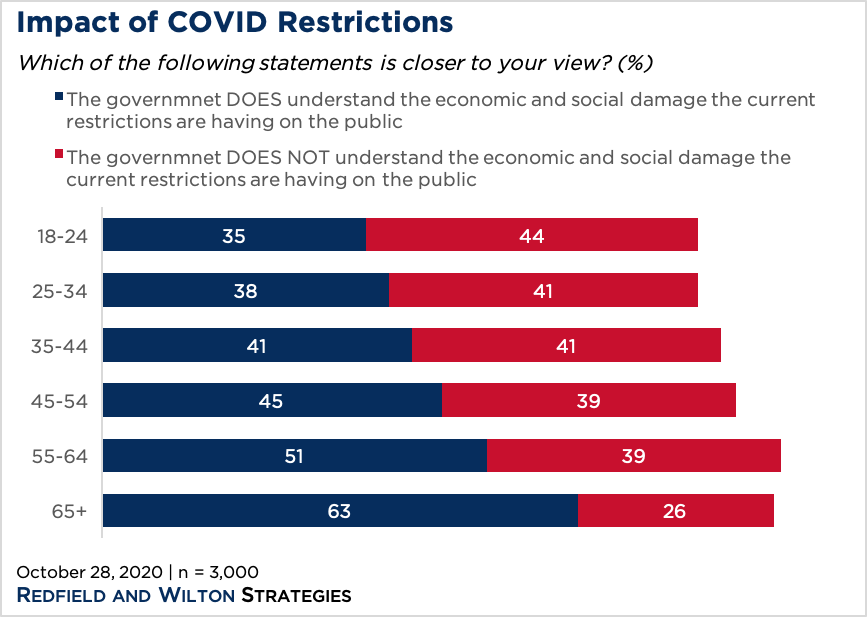Global Public Opinion Shows Fear, Caution as COVID-19 Lockdowns Renew

The Chicago Council Survey team provides updates on public opinion on the COVID-19 pandemic from the US, Japan, South Korea, France, the United Kingdom, Italy, Canada, Germany, and Mexico.
Introduction
This week the world passed the 52.2 million case mark, with over 1.2 million deaths attributed to COVID-19. With Pfizer’s announcement that their COVID-19 vaccine has been more than 90 percent effective in preventing infections in test trials, the prospects of an end to the pandemic have inched into sight. However, it remains to be seen whether the Food and Drug Administration will grant Pfizer the emergency authorization later this month.
The Council survey team is providing updates every other week on public opinion around the world on the COVID-19 pandemic. This week, the Chicago Council Survey team’s update includes polling results from the United States, Japan, South Korea, France, the United Kingdom, Italy, Canada, Germany, and Mexico.
Key Findings
- In pre-election polling, majority of registered American voters (55%) said the worst of the pandemic is yet to come—similar to levels in March when the pandemic was just beginning.
- Japanese are staying home for the holidays: two-thirds (67%) say they do not plan to go home or travel for the New Year’s holiday this year.
- In South Korea, the rate of new cases has been brought under control and just 30 percent are concerned about becoming infected, down from 42 percent in September.
- As France’s second lockdown comes into effect, 71 percent of French people say they are in favor of it and 90 percent say they will respect the lockdown restrictions.
- In the United Kingdom, younger Britons are showing signs of discontent as they are more likely than older Britons to agree that the government does not understand the economic and social damage the current restrictions are having on the public.
- While 71 percent of Canadians say that others are doing a fine job in taking precautions to stop the virus’ spread, nearly half (48%) believe it is time for things to return to normal.
- Although Germany unveiled an app to facilitate contact tracing, just 34 percent of Germans have downloaded it and 73 percent say it does not protect them.
- Less than half (47%) of Italians say they will get the vaccine as soon as it is made available, with 15 percent saying they will wait to see how others respond to it. A full 30 percent say they will never get it.
- As cases remain elevated in Mexico, a large majority of Mexicans (81%) are afraid that themselves or a family member will contract the virus and 70 percent fear dying as a result of the virus.
United States
10,474,016 cases, 241,689 deaths
The United States has a new President-Elect. The Associated Press and other news networks called the election for Biden on Saturday, November 7 following several days of anxious waiting while votes were counted across the country.
The first challenge facing the incoming Biden-Harris administration will be the pandemic, an issue that many Biden supporters said was very important to their vote (82%, in an October Pew poll). And a major challenge for the administration will be in the PR fight: Axios/Ipsos polling finds that six in ten Americans (62%) say the government is making the US recovery from the pandemic worse, not better.
On Monday, Biden named 13 health experts to a COVID-19 Transition Advisory Board, saying that “the coronavirus pandemic is one of the most important battles our administration will face,” and that his administration’s efforts “will be informed by science and by experts.” Some good news in the fight against the pandemic came early in the week as well, with Pfizer reporting that its COVID-19 vaccine is more than 90% effective in early trials. But a vaccine is still months away from broad release, and the US is not in a good place. The country is facing another wave of infections at record levels. And now winter is ahead of us, pushing Americans from safer outdoor environments into the transmission-friendly indoors.
Americans see hard times ahead. NBC News/Wall Street Journal polling from late October finds a majority of registered American voters (55%) saying the worst of the pandemic is yet to come, not too far from what Americans said at the beginning of the pandemic in March, when six in ten (60%) thought the worst was still to come. This new wave comes at a hard time, with the American holiday season rapidly approaching. Two-thirds of Americans (66%) say traveling for the upcoming holidays is a large or moderate risk, per the most recent Axios/Ipsos poll.
This pollster, for one, won’t be traveling: Chicago is in the middle of a second wave of frightening proportions. Best to stay home.
Japan
112,407 cases, 1,858 deaths
A new surge in cases in Hokkaido, Japan's largest and northernmost prefecture, has health officials in Japan alarmed. Though the 150 to 200 new daily cases is small by comparison to what is currently going on in the US and many European countries, preventing these smaller outbreaks from spreading has been key to Japan’s coronavirus response.
Still, with a generally better COVID situation nationwide, the public is also feeling a bit more positive about the government’s anti-coronavirus efforts. In NHK polls, six in ten (60%) give the government positive marks, up from 54 percent in October and 51 percent in September.
With winter coming, Japan is looking ahead to the New Year’s holiday—and largely deciding to stay at home. NHK polling finds that two-thirds of Japanese (67%) say they do not plan to go home or travel for the New Year’s holiday, while two in ten (20%) have yet to decide. The public is also split on government efforts to encourage domestic travel, the “GoTo Travel” program. TBS/JNN polling finds that a plurality of Japanese (49%) say the program is inappropriate, while a smaller proportion (42%) favor it.
For those Japanese who are itching to travel, new routes are starting to open up. Hawaii recently loosened travel restrictions for visitors coming from Japan, allowing tourists who test negative before traveling to skip Hawaii’s two-week quarantine period. However, the reverse is not true: travelers will still need to quarantine for two weeks upon their return to Japan.
South Korea
27,942 cases, 487 deaths
As of November 8, South Korea saw 27,247 coronavirus cases and 478 deaths nationwide. The average number of weekly cases since mid-October hovered around 80, a significant decrease from late August and September, when the country registered up to 371 cases a week. With the decrease in cases since August, social distancing orders were relaxed to Level 1, the lowest on the new 5-tier scale. However, South Chungcheong Province, remains at Level 1.5 following a small outbreak in the municipality of Cheonan.
As the number of cases has decreased, fear of infection amongst the public has decreased as well. According to Gallup Korea, three in ten (30%) say they were very worried about being infected, compared to 42 percent in September. Moreover, there was a 7 percent increase from 67 percent to 74 percent in positive feedback for the Korean government’s handling of the pandemic compared to August. The decrease in cases since August is cited as the reason for this increase.
However, some Korean news media outlets are expressing concern about the relaxation of social distancing and the possibility of future resurgences. Despite the lower rates of infection, KBS reports voiced concern that increasing the level from one to 1.5 nationwide may be necessary especially due to the risk of group infections. For example, it was reported that there were 13 confirmed cases in Seocho-gu, Seoul as a result of a group meeting.
Notably, Everland—a Korean amusement park—and Itaewon—a popular nightlife area—became a trending topic on Halloween as pictures of crowds in both places went viral on social media. Photos showed hundreds of people gathering in large crowds without proper social distancing at both places, inciting anger from citizens. Some went as far as to say people found guilty of breaking COVID-19 precautions should be tracked and fined. However, some argue that everyday restrictions cannot last forever, hinting at some division in opinion amongst the Korean public regarding COVID-19 regulations.
France
1,865,538 cases, 42,535 deaths
On October 30, France entered its second national lockdown due to surging cases of COVID-19. Cases have been rising sharply since October and show no signs of letting up in the first weeks of November. While the lockdown is set to last at least four weeks, President Macron has suggested that certain businesses could be reopened on November 15 if the public heath situation has improved by then; regardless, the lockdown will continue until at least December 1. In general, the French people are in favor of the lockdown, with 71 percent expressing favorability towards it in a November 3-4 Elabe poll. Moreover, 90 percent say that they respect the new lockdown restrictions and 82 percent say they will strictly respect a 9pm curfew if it is imposed in their area.
Despite plans to potentially reopen non-essential businesses on November 15, the steady rise of cases suggests that these firms will remain closed for the duration of the lockdown. Amid an already bleak view of France’s economic prospects, this projection represents another blow to many small businesses. According to an October 28-29 Odoxa poll, 87 percent of French people said that they are not confident about the future of the economic situation in France: the highest proportion since this question was first asked in December 2006.
In fact, a strong majority of French respondents (69%) believe that the second wave of the coronavirus pandemic will provoke a major and long-lasting economic crisis similar to that of 2008. This represents an increase of 40 points from when this question was asked about the first wave of the pandemic in March.
While the French government has rolled out programs like ‘partial unemployment’ as well as revealed their plan to restart the economy, French people do not believe that these are sufficient to avoid a large increase in unemployment (63%), to avoid an increase in the number of business bankruptcies (62%), or to avoid a decrease in French purchasing power (62%), according to a November 3-4 Elabe survey. Nonetheless, two thirds of French respondents (66%) believe that the most important thing to do is limit the COVID-19 pandemic, even if it has a negative effect on the economy and employment.
The United Kingdom
1,256,725 cases, 50,365 deaths
As of Thursday, November 5, the United Kingdom entered its second national lockdown of the coronavirus pandemic as cases surged throughout October and have begun to plateau in November. All non-essential businesses are closed, indoor gatherings of multiple households are forbidden, and Britons are urged to stay home except for education and work; schools, universities, and colleges remain open. As many businesses close once again, more than a third of Britons (37%) say that they expect their financial situation to worsen in the next three months, according to an October 28 Redfield and Wilton poll. But two-thirds of Britons (65%) say that they are fully adhering to the increased restrictions in their area, and with the rate of infections plateauing over the last week, it is possible that Britain will avoid the need for a prolonged lockdown.
However, the poll also shows that younger people may be more inclined to resist adherence to the increased restrictions. British youths are more likely than older Britons to believe that the government does not understand the economic and social damage the current restrictions are having on the public. Indeed, majorities of British youths aged 18-24 (56%) and 25-34 (58%) agree that the younger generations are being asked to make too large a financial sacrifice as a result of the local or national lockdowns that are primarily intended to protect the elderly. By contrast, just 34 percent of those aged 45-54 and 26 percent of those aged 55-64 agree.

Meanwhile, a controversy over the government’s decision to end a school meal voucher program led to a popular campaign to continue the program, with footballer Marcus Rashford leading the charge. Thanks to his campaign, a massive outpouring of public support for the meal voucher program has caused the government to reverse course and spend more than £400 million to support the program which benefits poor children.
Prior to this change in policy however, a Redfield and Wilton poll fielded on October 28 found that two-thirds of Britons (66%) agree that the government should extend free meals for poorer pupils to school holidays. Even when asked to consider the amount of money that the government has already spent this year on COVID related schemes and stimulus packages, over half of British respondents (52%) say that the government should commit to funding free school meals for all holidays after the pandemic. Despite public support for the government’s change in policy, 54 percent of British people say that the government’s handling of this controversy has been incompetent.
Italy
1,028,424 cases, 42,953 deaths
With new coronavirus cases and coronavirus-related deaths rapidly rising, Italy has adopted a three-tiered system to divide the country based on the intensity of coronavirus outbreaks. The three tiers are yellow, orange, and red, in order of escalating intensity. On Monday, four regions were raised from yellow to orange status, meaning that these regions will be ordered to close all bars and restaurants, and while residents may travel within their city freely, they are not allowed to leave them.
A majority of Italians seem to be unhappy with the way the pandemic is being handled by the government. According to an Ipsos survey conducted October 30, 53 percent think the government is not doing a good job handling the second wave of the pandemic, while 43 percent think it is. However, a majority of people (62%) agree with the government’s decision to introduce a lockdown strategy that targets regions. Much smaller shares of Italians believe that there should be a total lockdown in every part of the country (18%) or that there should not be a lockdown anywhere (15%).
Despite many Italians’ negative opinions of the government’s handling of the pandemic, a majority of Italians recognize that it is Italian citizens who have the most impact on the direction the pandemic takes. Almost two thirds (63%) say the increase in new cases has been caused by the wrong actions of citizens, while only 29 percent say it is due to wrong decisions made by the national and regional governments.
With new information about the Pfizer vaccine coming out this past week, Italy and the EU havestarted making plans to purchase a large number of doses. On Monday, the president of the European Commission, Ursula von der Leyen, announced on twitter that the EU will soon sign a contract with Pfizer and Biontech to obtain 300 million doses to then spread out among EU member nations.
But while many politicians seem to be hopeful about the new vaccine, according to a Quotidiano& survey from November 8, less than half of Italians (47%) say they would take the vaccine as soon as it is ready. Fifteen percent say they would wait to see how other people react to taking it, and a full 30 percent say they would not take it at all. Opinions also differ on when the vaccine will be ready. Only 10 percent say they think the vaccine will be ready by the end of 2020, one third (32%) saying they think it will be ready by next spring or summer, and 21 percent think it will take one year. Nearly 3 in 10 (29%) say they think it will take over a year.
Canada
277,061 cases, 10,685 deaths
Commenting on news that Pfizer’s COVID-19 vaccine may be 90 percent effective in stopping the virus, Canadian Prime Minister Justin Trudeau said, “We see the light at the end of the tunnel.” That vaccine may not come soon enough as Canada continues to face a rise in its infections and deaths. Canada has experienced a 52 percent increase in reported infections and an 84 percent increase in deaths over the last two weeks, pushing its seven-day case average to the highest levels seen so far. This average stood at 3,896 new cases as of Sunday.
In another worrying sign, the country recently saw its greatest number of cases reported so far in a single day, with 4,248 cases announced on Saturday. While case numbers are rising on a national level, more restrictions from provincial or national government authorities do not seem to be imminent. The one major exception to this as of now is British Columbia where the government has recently instituted a set of restrictions aimed at preventing infections originating from indoor group exercise classes, informal gatherings, and more. In effect for two weeks, these are focused on slowing the virus’ spread in Vancouver and surrounding areas.
A recently released online, representative survey conducted by the Angus Reid Institute from October 20-22 sheds some light on how Canadians are coping with the country’s rise in infections. Most Canadians (71%) reported that they feel others are doing a fine job in taking precautions to stop the virus’ spread, such as wearing masks and social distancing. Still, over half of Canadians (54%) noted that they feel these restrictions are fatiguing, suggesting that compliance with them may start to slip. This may have informed the opinion of nearly half of the respondents (48%) who feel it is time for things to return to “normal.” However, even with the fatigue they may be feeling over restrictions and a desire to move on from the virus, the majority of Canadians (52%) are confident that they will be able to quickly lower the number of cases in the country.
Mexico
986,177 cases, 96,430 deaths
Per a decree issued by Mexican President Andrés Manuel López Obrador, October 31 marked the beginning of three days of national mourning, coinciding with its usual two-day celebration of Día de Muertos. Hugo López-Gatell, Undersecretary of Prevention and Health Promotion and leader of the Mexican government’s COVID-19 task force, previously warned of cemeteries becoming “areas of high risk for contagion” should celebrations have been allowed to continue as normal. The same day as the announcement, Mexico City Mayor Claudia Sheinbaum confirmed that she had tested positive for the virus and was under isolation.
As of November 9, the northern state of Durango became the second in Mexico to enter the highest level of coronavirus alert, joining the neighboring state of Chihuahua. Like much of the rest of the world, Mexico has seen cases steadily rise in recent weeks. According to the Mexican National Council for Science and Technology, confirmed cases stand at 972,785 with deaths at 95,225 (though estimates are much higher), giving it the fourth highest death toll in the world. Though lockdowns ended in June, the government has been wary to re-implement such policies for economic reasons.
The 40th edition of Mitofsky’s daily coronavirus poll, last updated on November 8, reveals a Mexico fearful of the virus but detached from the scientific and political processes surrounding it. The vast majority (81%) indicate that they are very or somewhat afraid that themselves or a family member will contract COVID-19, while a record number (70%) fear dying as a result of contracting the virus. Only 12 percent of responders claim to have been tested, a reflection of Mexico's underfunded and imbalanced national healthcare system.
Those surveyed also indicated a reluctance toward a vaccine, at least initially. Though nearly 63 percent indicated that they would like to be tested immediately if it were available, only around 28 percent said that they would like to be one of the first to be vaccinated, while over half (51%) expressed a preference to wait until after the first rounds. In a similar vein, when Pfizer announced their reportedly-90 percent effective COVID vaccine, Undersecretary López-Gatell pointed to a need to remain cautious and wait for the response of the scientific community. Most trust Undersecretary López-Gatell's daily briefings to some degree (60%) and 55 percent have a positive opinion of him.
Germany
727,553 cases, 11,982 deaths
Despite initial success in responding to the spread of COVID-19, Germany is currently grappling with a second wave of the virus. To some degree, Germany’s rise in cases reflects Germans’ ambivalence about the disease. A late June survey conducted by Deutsche Welle, one of Germany's top pollsters, reflected that Germans were more afraid of Trump getting elected (51%) than catching a serious illness such as the coronavirus (32%).
Nonetheless, an August 28th study by ZDF, another major source of German polling data, indicated that a majority of Germans (77%) favored stronger measures to protect against the spread of the virus. Only 21% of Germans opposed stronger protective measures. While most Germans acknowledge the importance of strong containment measures, the average German does not feel personally concerned about catching the virus.
Importantly, there may be a shift in such perception now that Germany faces a second national lockdown. In late June, July, and August, when the ZDF and DW studies were conducted, the rate of new COVID-19 cases was plateauing in Germany. Now, however, cases in Germany are skyrocketing. The German government announced a month-long, partial lockdown that began on November 2.
During this lockdown, public opinion appears to be more skeptical about government protection measures. For instance, back in June, the German government developed an app to warn about COVID-19. While downloading the app was not mandatory, it was highly encouraged. But the tool can only be effective if roughly 60 percent of Germans actively use it. But as of October 22only 34 percent of Germans surveyed had downloaded the app. Moreover, of the app users, 73 percent did not feel that the app is protective.





